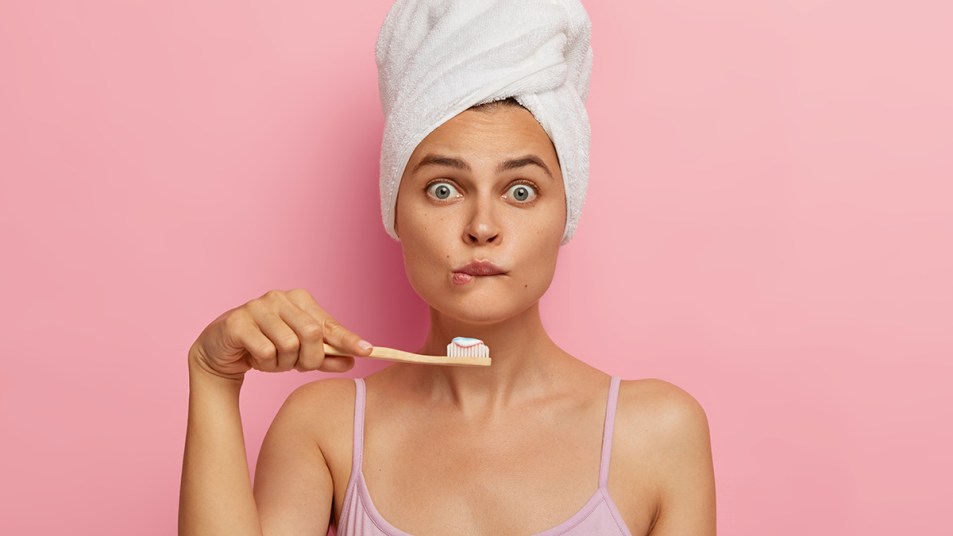How Often Should You Replace Your Toothbrush? More Often Than You Think
Even though it looks fine, an older toothbrush could be putting you at risk.

Sure, you brush your teeth morning and night, and you even floss regularly. But when is the last time you’ve replaced your toothbrush? “The average person should be swapping out for a new toothbrush every three to four months,” explains Dr. Sienna Palmer, DDS, dentist at Meridien Dental in Santa Monica, CA. “This is recommended to ensure that the bristles are still effective and bacteria accumulation on the toothbrush is minimal.” So even if your toothbrush looks completely fine, it could be time for a change.
What happens if you don’t replace your toothbrush?
The short answer: Using an old toothbrush diminishes your oral health. According to the American Dental Association (ADA), you should replace a manual or electric toothbrush every three to four months when the bristles appear frayed. (One exception to this rule: Get a new toothbrush sooner if you’re recovering from being ill in order to prevent reinfection.)
Not replacing your toothbrush regularly allows an excess of plaque to sit on your teeth. This can eventually cause gingivitis, a mild form of gum disease that triggers redness and swelling around your gums. Additionally, an old toothbrush is a breeding ground for bacteria — which is a culprit of bad breath. These are two of the several risks of using a ragged toothbrush, which gives you enough reason to buy a new one. (Click through to see our best gum disease self-care tips.)
How do you choose a new toothbrush?
In order to replace your toothbrush, you could simply get an unused version of the kind of toothbrush you’re already accustomed to. This is ideal if the toothbrush successfully removes food particles and plaque from your teeth. Alternatively, you may want to look for a different type of toothbrush if you suspect yours is not doing the job properly.
You can always get toothbrush recommendations from your dentist during a visit. You can also use this guide from Colgate’s website to find a new toothbrush that promotes good dental health:
- Manual or electric/battery-powered toothbrush: The choice is yours on which type of toothbrush will best suit your teeth. However, it’s worth considering a powered toothbrush in cases where you have restricted manual dexterity or usually brush too hard. Either way, be sure to spend two minutes each time you brush twice a day.
- ADA Seal of Acceptance: This seal signifies that independent experts have verified the toothbrush’s effectiveness and safety.
- Type of bristles: Soft-bristled brushes are often recommended for teeth, as medium and stiff kinds can be harsh on gum and enamel. Lean towards a soft brush, unless your dentist advises using a medium or stiff toothbrush.
- Size of toothbrush head: A bigger brush head doesn’t always mean better results. In many cases, a small-headed toothbrush does wonders for targeting all areas of the mouth.
- Brush handle: Choosing a toothbrush with the right brush handle allows you to thoroughly clean your teeth without discomfort. Brushes with an angled or flexible-neck handle helps you reach all of your teeth, while a non-slip grip handle ensures the brush stays in your hand even while it’s wet.
- Your favorite color: You’ll be using this toothbrush twice daily for the next few months. So, pick one in your favorite color to make brushing less of a hassle and more fun!
Once you’ve bought a new toothbrush, store it correctly in your bathroom to prevent contamination. Below, you can find step-by-step instructions for how to store a toothbrush from ADA dentist Matthew Messina, DDS.
Should you cover your toothbrush in the bathroom?
You should not cover your toothbrush while storing it. Why? Because it prevents the brush from drying, and keeps the bacteria trapped on the surface. Dr. Messina shares the best way to store your toothbrush when you’re not using it on the ADA’s website:
- After brushing your teeth, rinse any toothpaste and saliva off the brush. Tap the handle of the toothbrush onto the sink’s outer rim to remove excess water.
- Put the toothbrush standing upright in a holder so it’s in open air and isn’t touching another toothbrush or item. Avoid putting the toothbrush holder near a toilet, as it could contaminate your brush with airborne bacteria when it’s flushed. (A manual toothbrush holder to try: HanleyDepot Mini Ceramic Toothbrush Holder Stand, Buy from Amazon, $5.99. An electric toothbrush holder to try: Cerpourt Toothbrush Holder, Buy from Amazon, starting at $7.49.)
- Allow the brush to air-dry to help the bacteria on the surface die off before using it again.
Click through to learn how to sanitize your toothbrush — plus more ways to get rid of germs in your house and how germs on your toothbrush can lead to norovirus.
The Bottom Line
Your trusty toothbrush isn’t infallible. At some point, it’ll need to be replaced — and your new one will require proper storage to stay in tip-top shape. But if you follow these tips and tricks, you’ll achieve a brighter, whiter smile; so start showing your toothbrush some love!
This content is not a substitute for professional medical advice or diagnosis. Always consult your physician before pursuing any treatment plan.












